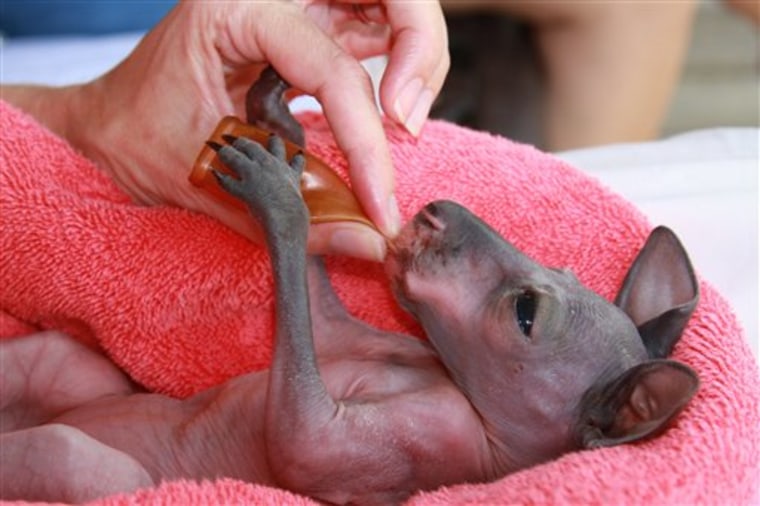Christina Cooper has been wearing a kangaroo lately — a foundling named Skippy, who was rejected by his mother at a wildlife park in eastern Louisiana.
Inside a canvas carryall over Cooper's shoulder is an artificial kangaroo pouch for the 6-month-old red kangaroo.
It's demanding duty — Skippy must be bottle fed every four hours, though he's starting to eat grass and other green stuff.
Workers at Global Wildlife Center in Folsom found the joey, as young 'roos are called, on the ground May 13 in the area where about 40 red kangaroos live.
Cooper, one of the park's two animal care specialists, waited about 90 minutes, hoping the mother would pick it up.
"That was really hard just to watch," Cooper said. "But the adults were really not interested in him. Nobody came to claim him."
He was probably about 4 months old and utterly helpless.
Though adult red kangaroos can grow more than 6 feet tall, a newborn joey is about the size of a jelly bean. Eyeless, earless, all but skinless and with only buds where its hind legs will be, a newborn hauls itself into its mother's pouch. There, the "pouch embryo" clamps its mouth onto a teat. It cannot even open its mouth for about a month, and usually stays attached for about six months.
Cooper doesn't know how or why Skippy came out of his mother's pouch. A female that is stressed or chased by a predator may expel a joey, Cooper said. But the Folsom reserve keeps no carnivores on its 900-acre property north of New Orleans.
When he was found, Skippy weighed a bit more than a pound. His head was smaller than a man's thumb.
Hairless at first, Skippy began to grow gray fur. Now, some of that fur is showing traces of the reddish-brown that gives the species its name.
Cooper had never hand-raised a wild animal before, let alone a kangaroo. She started with a call to a friend at the Baton Rouge Zoo, some urgent Internet research, a rush order for "The Complete Guide to The Care of Macropods" — a scientific name that translates roughly as "hugefoot" — and an e-mail to its author, Lynda Staker, an Australian kangaroo rescuer.
"I had read previously that the best way to regulate the body temperature in an animal that young is to wear them. Put them close to your skin, inside your clothes," Cooper said.
So she turned a sweatshirt into an impromptu pouch and wore it inside another shirt and a warm fleece jacket. "That's pretty unbearable in May in Louisiana," she said.
As soon as she had the jacket on, she drove Skippy to the Baton Rouge Zoo, where the zoo's veterinarian mixed a batch of powdered milk substitute and cleaned the baby.
The Baton Rouge Zoo also provided an emergency supply of kangaroo milk replacer, tiny bottles and the long, flexible nipples needed for kangaroos. Cooper ordered more from Wombaroo, an Australian company that makes milk replacement for domestic animals, marsupials and zoo animals.
She wore Skippy and extra clothes for two days, sitting in an armchair to sleep. Arrival of an incubator let her return to a single shirt, but she still had to feed Skippy every two hours.
After 12 days in the incubator, Skippy lived in pouches sent by Staker. He had to stay on his back, with his feet near his head, to ensure normal development of hind leg tendons and muscles.
Now weighing about 3 pounds, he took his first wobbly steps June 30, and his first hops July 4. In about two or three months, he'll be at the age when red kangaroos leave the pouch for good.
"We're really at a stage where he's growing by leaps and bounds," said Cooper.
